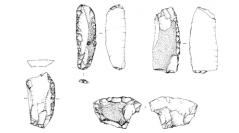

 Comptes Rendus Palevol
12 (4) - Pages 211-221
Comptes Rendus Palevol
12 (4) - Pages 211-221Neanderthals left diverse sets of cultural evidence just before the Middle–Upper Palaeolithic transition in Europe. Within this evidence, the production of lithic implements plays a key role in detecting possible affiliations (or lack thereof) with the techno-complexes that occurred during the few millennia before the large-scale spread of the Proto-Aurignacian. This crucial phase has also been recorded in the North of Italy, where around 44–45 ky cal BP, the last Neanderthals were still using the Levallois knapping technique, in common with the technology adopted at several sites in the central Mediterranean region. A similar picture is seen at the Grotta di Fumane, which provides the evidence presented in this paper. The production technology employed produced different levels of variability with respect to the production of blades, sometimes pointed, and the use of recurrent centripetal flaking at the end of the reduction sequence, in addition to bladelet and Discoidal volumetric structures. This variability does not outweigh the dominant tendency towards the use of elongated Levallois blanks and other by-products for shaping into basic retouched tools such as simple or convergent scrapers and points. A break from this apparently well-rooted use of the unipolar Levallois method is recorded in the Uluzzian where, instead, flakes and cores were made using the centripetal modality.
Middle Paleolithic, Behaviour, Levallois, MIS3, Italy